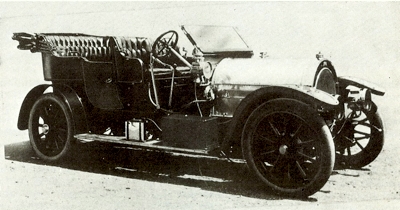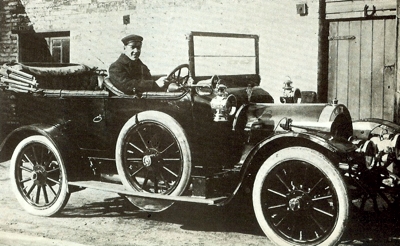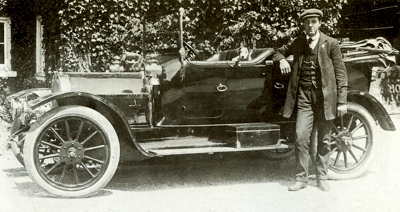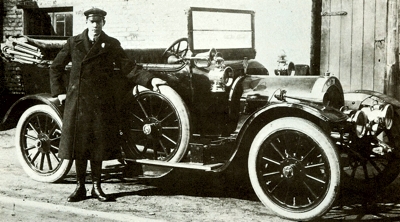Coventry was always regarded as the centre of the British motor industry, and one of the many was the Maudslay, built at Parkside. It was a good car notable for advanced design, in the early and late manifestations of the make. However, it was scarcely a well known car in later times, when Maudslay commercials were more in the public eye.
The Maudslay Company had a high reputation as engineers long before it turned to making cars. From around 1790, Maudslay had made steam engines in Lambeth, and later it was to have the distinction of supplying boilers for the pioneer battleships of the Royal Navy. Other important contributions to steam engineering were made by Maudslay Sons & Field, and in 1902 they reached the decision that it was time they entered the then-accelerating motor industry.
This automotive branch was founded by Walter H. Maudslay, great grandson of the eminent engineer Henry Maudslay to make marine internal combustion engines. He was joined by his sons Cyril and Reginald Walter but the latter soon left to found the Standard Motor Company.
Alex Craig
First they needed a designer, so they secured the services of Alex Craig, a freelance designer who had a penchant for the overhead camshaft long before this became a recognised way of operating overhead valves, and who liked to site his engines beneath the floor of the vehicle. He also provided engines for the early Standard and Lea-Francis cars.
What is interesting is that Craig was apparently concerned that his overhead camshaft valve gear would be accused of being inaccessible, because he arranged for the entire camshaft to hinge over clear of the valves, rendering these easily available for removal through detachable valve caps. Another significant piece of advanced thinking attributable to Alexander Craig was the use of full-pressure lubrication, at a period when too many automobile engines had to make do with drip-feeds or splash oiling.
So Maudslay, who had moved to Coventry for their venture into motor-car manufacture, got off to a good start. Their first venture was a three-cylinder 20 hp. By doubling the form of this first engine, they were able to enter the distinguished six-cylinder market as early as 1904 and, as they had evolved a silent gearbox employing internal chains, they were able to claim some degree of silent functioning that was soon to be a Rolls-Royce preserve.
The Maudslay Sweet Seventeen
In 1905 they adopted the circular formation of radiator as their hall-mark, in company with such makers as Delaunay-Belleville. It was mainly in four-cylinder form that these round-radiatored Maudslays made their name, as solidly constructed, dependable cars of long-wearing quality. They were made as 17, 25/30 and 35/45 hp models. The first of these gained the title of the 'Sweet Seventeen'. It had a 90 x 130mm engine, with the overhead, hinged camshaft, and was sold in chassis form for UK£425 in 1910, at which time the 35/45 Maudslay cost UK£700 without bodywork.
When war engulfed the country and the motor industry in 1914, the respected Coventry concern was building the 17 hp car and a 27 hp six-cylinder vehicle, which used cylinders of the same dimensions as those of the four-cylinder model. Apart from the ohc engine, the rest of the later Maudslay cars were conventional, with the engine at the front and the springing by half-elliptic at the front and three-quarter-elliptics at the back. They were heavy, even ponderous, motor-cars, not renowned for speed, but were rugged, durable and very honestly made.
 1909 Maudslay 17 hp.
1909 Maudslay 17 hp.
 1913 Maudslay 17 hp four-seater.
1913 Maudslay 17 hp four-seater.
 1913 Maudslay 17 hp "Sweet Seventeen". It featured a 90 x 130 mm four cylinder engine.
1913 Maudslay 17 hp "Sweet Seventeen". It featured a 90 x 130 mm four cylinder engine.
 1913 Maudslay 17 hp "Sweet Seventeen".
1913 Maudslay 17 hp "Sweet Seventeen". |
However, for all their good reputation, Maudslay private cars did not reappear after World War 1 was over. Instead, the Coventry manufacturer turned to commercial vehicles, as perhaps more suited to its heavy-engineering sympathies. It was not until 1923 (by which time Maudslay trucks and buses were well known) that there were rumours of a return to motor-car manufacture. Although this revived Maudslay was never to get into production, it at least carried on the former tradition of advanced thinking beneath its bonnet; the former radiator shape, however, was abandoned.
The Post-War Maudslay
The post-war design was the work of J. A. Kemp (who later moved on to the Albion Company which was by then a pure commercial vehicle concern) and J. R. Hamilton. Their good intentions were appropriately supervised by Mr Craig. This new car was to be a high-performance tourer of medium size and engine capacity, and to be known as the 15/80 Model 2LS Maudslay.
The engine size was 2 liters, from six 65 x 100 mm cylinders, and the significant thing was that the overhead valves were prodded by a camshaft above each line of valves. Moreover, these camshafts were driven such as vertical shaft-and-bevel or worm-and-wheel gears, a noisy train of gear wheels, or by one or more threshing driving chains, but by coupling rods and eccentrics. This was a bid to gain the volumetric advantages of good breathing that overhead valves conveyed.
This exciting 2-liter Maudslay, which was to have sold for UK£825, deserved a better fate. It not only had this clever valve gear but it used roller bearings throughout, just like a hand-built racing-car engine, and it was a sleek chassis retarded by means of Perrot-type front-wheel brakes. But it never got as far as the motoring public.
The Maudslay 2LS
The intention had been to make the announcement of the new 2LS Maudslay during the 1923 London Motor Show at Olympia. For this purpose, the design was finalised, and a Show chassis was hurriedly completed. It was sent to the coach-builders for the mounting of its Show body but, before this had been done, the Maudslay was destroyed by a fire that broke out at the bodyshop.
Another 2LS chassis was hastily substituted, which had actually been a test hack, but this effort was to no avail and nothing more was heard of the Maudslay car, although the companies commercial vehicles thrived. They also continued with the twin-over-head-camshaft theme, on a six-cylinder bus engine, which may have been attributed to their car development (but we cannot prove the claim - if you have any information please send us an email).
Associated Commercial Vehicles (ACV) Ltd
In 1948, Maudslay joined AEC and Crossley in the new Associated Commercial Vehicles (ACV) Ltd. The name was kept on at first, but in 1950 it was phased out. A name famous in the engineering world was effaced after some 160 years, during which time there had been Maudslay boilers in Sir Gouldsworth Gurney's steam-car in Victorian steam fire-engines, and in the Amedee Bollee steam carriages of long ago, not to overlook the fact that the huge paddle engine in the famous Great Eastern steamship was a Maudslay product.
As it is, the motor-car side of this famous company is probably best remembered by the stolid pre-1914 models it conscientiously turned out.
